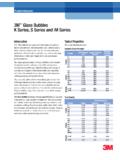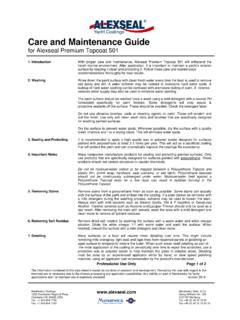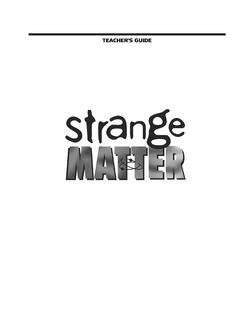Transcription of Product Standards update - TriStar Glass
1 Product Standards Updated January- 2013 This reference guide documents quality and Product Standards associated with TriStar Glass , Inc.'s fabrication of architectural flat Glass . It contains, but is not limited to, information regarding the proper inspection of and associated tolerances for: flat, heat- treated, coated, and laminated Glass . This document draws heavily from the ASTM Standards C1036, C1048, C1172, and C1376, however, these documents should be referenced in full for a comprehensive listing of each standard. Table of Contents Introduction .. 3 Standard Specifications for Flat Glass .. 4 Monolithic Dimensional Tolerances .. 4 Edge chips .. 4 Blemishes in Monolithic Flat Glass .. 5 Reflective or Low- E Coated Glass .. 7 Coating Blemishes: .. 7 Coating Uniformity and Color Variation: .. 7 Distortion in Insulated Units: .. 8 Laminated Glass .. 9 Blemishes in Laminated Glass .
2 9 Bow and Warp in Laminated Glass .. 9 Laminated Glass Mismatch .. 10 Uniformity and Color Variation in Laminated Glass .. 10 Optical Distortion in Laminated Glass .. 11 Tempered and Heat Strengthened .. 12 Distortion in Heat- Treated Glass .. 12 Strain Pattern in Heat- Treated Glass .. 13 Fabrication of Heat- Treated Glass .. 13 Placement: .. 13 Tolerance: .. 13 Spandrel Glass .. 14 Product Standards TriStar Glass , Inc. Product Standards are based on the following ASTM documents. Complete versions of these documents are subject to copyright and may only be obtained directly from ASTM ( ) ASTM C- 1036 Standard Specification for Flat Glass ASTM C- 1048 Standard Specification for Heat Strengthened and Fully Tempered Flat Glass ASTM C- 1172 Standard Specification for Laminated Architectural Flat Glass ASTM C- 1376 Standard Specification for Pyrolytic and Vacuum Deposition Coatings on Flat Glass Introduction High- precision automated machinery allows TriStar to maintain a strong balance between artisanal quality and computer- controlled speed of production.
3 It should be noted, however, that the fabrication processes used to create TriStar 's Glass products often subject the Glass to high temperatures, pressures, and sometimes a significant amount of handling between each process. While these processes are necessary to afford our Glass products with additional strength, safety, or efficiency, they can be known to cause slight flaws in the surface of the Glass that may be visible should the Glass be overly scrutinized. The above ASTM Standards have been created to define official viewing conditions that determine the acceptable limits of these flaws, optically and aesthetically. These Standards also address safety concerns, rejecting any such flaw that may cause the Glass to break or fail. All of TriStar Glass ' quality and production Standards are designed to meet or exceed those set forth by ASTM and in most cases are above the industry standard.
4 Standard Specifications for Flat Glass Monolithic Dimensional Tolerances Tolerances for length, width, and squareness for rectangular and nonrectangular shapes shall be determined by the following table: Glass Thickness Length and width Tolerance Diagonal Tolerance Cut Size Stock Sheet Cut Size Stock Sheet 3/32"- 1/4" 1/16" 1/4" 5/64" 1/8" 5/16" 5/64" 1/4" 7/64" 1/4" 3/8" 3/32" 1/4" 1/8" 1/4" 1/2" 1/8" 1/4" 11/64" 3/8" Table 1: dimensional tolerances for monolithic flat Glass Edge chips The following criteria are NOT ALLOWED: Chip depth > 50% of Glass thickness Chip width > Glass thickness or 1/4in (whichever is greater) Chip length > 2x chip width Any V - chips, v- shaped imperfections in the edge of the Glass , found within a production lite will cause the entire lite to be rejected. Blemishes in Monolithic Flat Glass A blemish is an imperfection in the body or on the surface of the Glass .
5 Linear blemishes include scratches, rubs, and digs and may be straight or curved in nature. Point blemishes include crush (light pitting), knots (lumps), dirt, stones and gaseous inclusions (cat eye). All visual blemish inspections shall be made with the naked eye viewing samples in the vertical position at a viewing angle of 90 to the specimen using daylight (without direct sunlight) or other uniform diffused background lighting that simulates daylight (minimum 1700 lux measured at the center of the Glass ). Figure 1: viewing in transmission Linear blemish intensity shall be determined by detection distance. Detection distance is obtained viewing the specimen from a distance of 13ft (4m) and progressing sequentially in, noting the distance at which the blemish is detected. Use the table on the following page to categorize a blemish and determine its acceptability.
6 Detection Blemish Distance Intensity 132in ( ) Heavy 39in (1m) Medium 8in (.2m) Light < 8in (.2m) Faint Table 2: detection distance vs. blemish intensity The following Line Blemishes are NOT ALLOWED: Multiple medium blemishes < 3 in that are within 24 in of each other Medium blemishes > 3 in Heavy blemishes Point blemishes shall be viewed from a distance of 39in (1m). Point blemish size shall be determined by measuring the max length and max perpendicular width of the blemish and averaging the two dimensions. The following point blemishes are NOT ALLOWED: Blemishes < .02in that form a detectable cluster at 6ft Multiple blemishes < within 24in* of each other Multiple blemishes < within 24in* of each other Blemishes *Separation distances are specified for thick Glass . Thicker Glass may contain proportionally larger blemishes for the same 24in separation distance. Blemishes in size ranges that are allowed without separation distance criteria shall not be compared with those that have separation criteria.
7 See applicable ASTM standard for pattern Glass products. Reflective or Low- E Coated Glass Coating Blemishes: The Glass shall be inspected, in transmission (see figure 1), at a distance of 10ft ( m) at a viewing angle of 90 to the specimen against a bright uniform background. If a blemish is readily apparent under these viewing conditions, the following criteria are NOT ALLOWED: Figure 2: viewing area Pinholes > 1/16 in diameter in the central 80% of the viewing area Pinholes > 3/32 in diameter in the outer 20% of the Glass area More than 2 readily apparent blemishes w/in a 3 diameter circle More than 5 readily apparent blemishes w/in a 12 diameter circle Scratches > 2 in the central 80% viewing area Scratches > 3 in the outer 20% viewing area Concentrated scratches or abraded areas Coating Uniformity and Color Variation: Visual observations of color differences on the exterior of a building are subjective and vary from person to person.
8 Perceived color variation can be the result of lighting conditions (both internal and external), distance and angle of observation, and the surrounding area. TriStar 's Glass products conform to industry color Standards . Variations in color and uniformity from one unit to another may occur and are not cause for rejection. Disparities in coloring could be the result of slight variations in the float Glass substrate or normal production variations. Distortion in Insulated Units: Sealed insulating Glass units, regardless of the Glass type, exhibit distortion. Air or other gas, sealed in the gap between the lites of Glass , expands or contracts with temperature and barometric changes, creating a pressure differential between the sealed gap and the atmosphere. The Glass reacts to the pressure differential by being deflected inward or outward. When inspecting for color uniformity and distortion, Glass should be viewed as installed from the exterior at a distance of 10ft ( ) at a viewing angle of 90 to the installation with standard day lighting in front of the Glass (see figure 3).
9 Figure 3: viewing color uniformity and distortion Laminated Glass Blemishes in Laminated Glass All visual inspections shall be made with the naked eye viewing samples in the vertical position at a viewing angle of 90 to the specimen using daylight (without direct sunlight) or other uniform diffused background lighting (see figure 1) that simulates daylight (minimum 1700 lux measured at the surface of the Glass facing the light source). The Glass shall be inspected at a distance of 39in ( m). If a blemish is readily apparent under these viewing conditions, refer below to Table 3 to determine acceptability: <25 square feet 25 square feet Blemish Outer Area, in. Outer Area, in. Central Area, in. Central Area, in. Covered Edge Exposed Edge Covered Edge Exposed Edge Bubbles 1/16 3/32 1/8 3/16 Blow- in/edge bubble N/A 1/4 1/16 N/A 1/4 1/16 Hair/Lint Light* Medium** Light* Medium** Inside dirt spot 1/16 3/32 3/32 5/32 Concentrated lint Light* Medium** Light* Medium** Short interlayer/ unlaminated area chip N/A 1/4 1/16 N/A 1/4 3/32 Scuff/streak Light* Medium** Medium** Medium** Table 3: maximum allowable laminating process blemishes (verticle glazing) *Light indicates: barely noticeable at 39in (1m) **Medium indicates: noticeable at 39in (1m) but not at 10ft (3m) Bow and Warp in Laminated Glass Bow/warp measurements shall take place with the Glass in a free standing vertical position with the longest edge resting on blocks at the quarter points.
10 With the laminate in this position, place a straightedge across the concave surface, parallel to and within 1in of the edge and measure the maximum deviation with a taper or feeler gage. A dial indicator may also be used. Below, Table 4 indicates the maximum allowable overall bow and warp for heat- treated laminated Glass Edge Dimension (in.) 0 18 >18 36 >36 48 >48 60 >60 72 >72 84 >84 96 >96 108 >108 120 >120 132 >132 144 >144 156 Laminate Make- up Maximum Bow (in.) Two Glass lites of, (in.) 1/8in to 3/16in 1/8 3/16 9/32 3/8 1/2 5/8 3/4 7/8 1 .. 1/4in 1/8 3/16 9/32 3/8 1/2 5/8 3/4 7/8 1 1 1/8 1 1/4 1/16 5/16in 3/32 5/32 7/32 9/32 11/32 7/16 9/16 11/16 13/16 15/16 11/16 1/16 3/16in 3/32 1/8 3/16 1/4 5/16 3/8 1/2 5/8 3/4 7/8 1 1/16 1/2in 1/16 3/32 1/8 3/16 1/4 9/32 3/8 1/2 5/8 3/4 7/8 1/16 Table 4: maximum allowable overall bow and warp for heat- treated laminated Glass Bow and Warp for annealed transparent Glass shall not exceed 1/16in per 12in of length Laminated Glass Mismatch Mismatch indicates misaligned edges of two lights when laminated.





